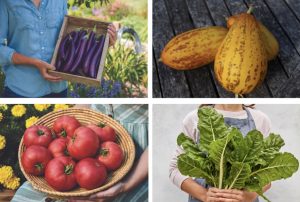Tips for Your Eco Garden in March – Spring usually arrives by mid-March and the frequent sunny days provide the opportunity for an increasing range of gardening tasks.
It’s time to get busy preparing seedbeds, sowing seed, cutting back winter shrubs and generally tidying up around the garden.
Things to do…
Flowers, Fruit and Veg – I love to see lots of colours in my garden. To help achieve this now is the time to plant summer flowering bulbs and to sow your hardy annuals in pots to provide colour later in the year.

The sun will always be shining if you grow Zinnia ‘Forecast’. These beautiful, single blossoms will shower your garden with colours of purple, pink, yellow and orange. Blooms are prolific from mid-summer to frost atop luscious green foliage.
Cultivating herbs in the garden can be surprisingly simple and the distance from plot to plate will be shorter than ever if in easy reach of your kitchen! Fresh basil, lemongrass and cilantro will bring beautiful aromas to your garden.
Many herb varieties offer the double benefit of beauty and taste, Chive ‘Allion’s flat-leaf, chive-like greens are tasty when young. Come spring, pretty flowering plants show off blazing purple masses of fragrant (non-edible) vertical spikes!
For your vegetable garden plant up your shallots, onion sets and early potatoes.
If you have limited space in the garden why not try a hanging herb and veggie garden, the perfect little space saver that looks attractive too and if you are feeling enthusiastic why not sow your own colourful kitchen!
Our friends at the Burpee Europe team have waved their wand of positivity again in 2022 to bring you the magic of their bright and cheerful veg seeds, to sprinkle liberally onto your gardens, greenhouses and finally, into your kitchens!
Nothing can be as sustainable or eco-friendly as growing your own foods. And nothing can be as healthy or invigorating as producing colourful veg, which as we all know, offer an abundance of health benefits depending on the hue.
 Aubergine ‘Violet Knight’ (also known as ‘Purple Knight’)
Aubergine ‘Violet Knight’ (also known as ‘Purple Knight’)
Is the newest member of the knight family, and is a pretty striking example of how un-boring aubergines can be! Prolific and easy to cultivate, with an adaptable plant habit, this variety is perfect for mid-sized containers or growing directly in the ground.
Cucumber ‘Brocade’ (previously called ‘Prolific’)
May not be brand new for this year, but has a hidden secret that has been discovered! It has been found that this fascinating and useful cucurbit is actually from the melon family! After tests, it has been revealed genetically as Cucumus melo, although it looks and is treated like a cooking cucumber. Fruits can be stored for months and have a high level of resistance to powdery and downy mildew.
Tomato ‘Rose Crush’
Is a rosy delight with its gorgeous pink colour! It has that lovely combo of an outstanding balance of taste of umami, sweetness and acidity. ‘Rose Crush’ is highly blight-resistant and produces a good yield of medium-large beefsteak fruit.
Swiss Chard ‘Fordhook Giant’
It has thick, dark-green tender leaves. The enticing, slightly bitter, earthy flavour offers itself to a number of dishes, especially those in which spinach is usually used. It is a dependable yielder, producing from late spring until winter even in hot weather. It LOVES the sun!
For the eco-minded why not try peat-free gardening – The large-scale removal of peat from bogs in Britain and Ireland is destroying one of our most precious wildlife habitats. It takes centuries for a peat bog to form, with its special wildlife – modern machinery destroys it in days.
Peat alternatives are available in most garden centers and DIY stores, or you can use your own compost. These alternatives are excellent in the garden if used in the right way.
Planting for wildlife – A wildlife-friendly garden doesn’t have to be wild and overgrown and it can look attractive all year round. I suggest you grow a wide variety of plants, by doing this you will offer food and shelter for all sorts of wildlife.
The size of your garden will limit what you can plant, but it’s possible to provide something on even the smallest balcony or terrace.
Greenhouses – On warm days, open vents and doors of greenhouses to reduce humidity and help prevent disease.
In colder areas, check that your glasshouse insulation remains secure.
Clear leaves and twigs from guttering on greenhouses and sheds.
Birds and Wildlife – March – April is when adult ladybirds become active and leave their overwintering sites to find food. Ladybirds are not only very pretty but they are also very good at keeping down the pest population. One ladybird can eat more than 4000 aphids in its lifetime!
Reclaim and Recycle – reclaimed Chimney Pots can be used for ornamental features in the garden or driveway and look really decorative. They make delightful flowerpots, especially when grouped together in different shapes and sizes.
Environment – benefits of natural drying your clothes
Nowadays it is all too easy to empty your washing machine and transfer it to your clothes dryer. What most people don’t realise however is the damage that running an electric clothes dryer has on the environment as well as the expensive running costs.
The biggest way to cut the environmental impact of cleaning clothes, therefore, is to stop or reduce the number of times you use an electric clothes dryer and to start using an outdoor clothesline instead.
There are also other advantages that result from using a clothesline to dry your clothes.
Constantly drying your clothes in a clothes dryer can damage the fibers of the garments as well as causing them to shrink and fade. The heat generated in an electric clothes dryer can also set stains whereas if the item is dried outside the bleaching effect of the sun can help to reduce the visibility of the stain.
Plus clothes smell great when they have been dried in the open air.
If you regularly use a clothesline to dry your washing give yourself a pat on the back because:
· YOU ARE SAVING ENERGY
· REDUCING POLLUTION
· PRESERVING THE ENVIRONMENT
Lilly Light


